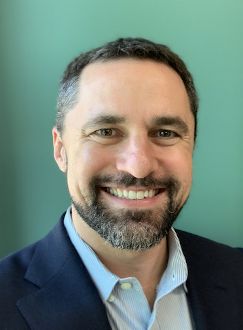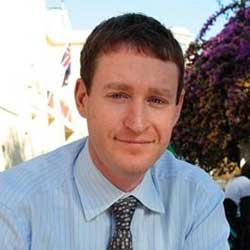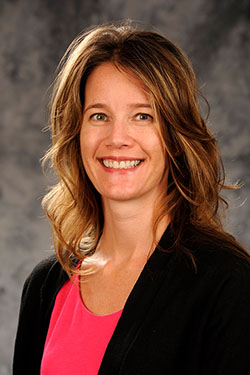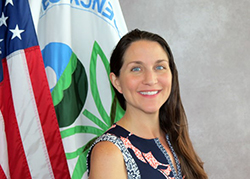Superfund Research Program Progress in Research Webinar Part 4: Emerging Exposures
Sponsored by: NIEHS Superfund Research Program
Archived: Thursday, November 19, 2020
Superfund Research Program Progress in Research Webinar Part 4: Emerging Exposures
2020-11-19
NIEHS Superfund Research Program
The NIEHS Superfund Research Program (SRP) Progress in Research webinar series highlights promising research from SRP Centers awarded grants in 2020. In this session, awardees from North Carolina State University, University of Iowa, and Louisiana State University will describe their research projects, accomplishments, and next steps.
The North Carolina State University SRP Center, "Center for Environmental and Health Effects of PFAS," focuses on per- and polyfluoroalkyl substances (PFAS) which are ubiquitous in the environment and have been associated with health effects such as cancer and thyroid, liver, and immune system toxicity. Despite this, these compounds have not been well-studied. Center scientists are investigating human exposure levels to PFAS in impacted areas, PFAS toxicity and the underlying mechanisms behind reduced thyroid and immune function, the potential for PFAS bioaccumulation, and effective remediation approaches for PFAS contamination.
The University of Iowa SRP (ISRP) Center, "Airborne PCBs: Sources, Exposures, Toxicities, Remediation," explores polychlorinated biphenyls (PCBs) and the health impacts stemming from inhalation of these toxic chemicals. Center scientists focus on neurodevelopmental and metabolic effects, particularly in adolescents, and the relationship to novel PCB exposure pathways in buildings such as schools. They aim to identify the mechanisms behind PCB interference with lipid metabolism, define the specific environments that contribute to inhalation exposure and its importance compared to dietary exposure, and develop cost-effective strategies to remove or reduce emissions.
The Louisiana State University SRP Center, "Environmentally Persistent Free Radicals (EPFRs)," studies an emerging class of contaminants which are produced during thermal treatment of hazardous wastes and have been shown to induce cardiac and pulmonary dysfunction in exposed populations. They are investigating mechanisms of EPFR-induced health impacts, determining how EPFRs form, stabilize, and decay, and demonstrating a link between EPFR exposure and poor respiratory health in children. The research goal is to understand how to attenuate EPFR formation, facilitate EPFR decay, and limit exposure to EPFRs.
Accessibility, Recording, and Content Disclaimer
Rehabilitation Act Notice for Reasonable Accommodation
It is EPA's policy to make reasonable accommodation to persons with disabilities wishing to participate in the agency's programs and activities, pursuant to the Rehabilitation Act of 1973, 29 U.S.C. 791. Any request for accommodation should be made to Kerri Voelker at 919-794-4710 or kerri.voelker@nih.gov, preferably one week or more in advance of the webinar, so that EPA will have sufficient time to process the request. EPA would welcome specific recommendations from requestors specifying the nature or type of accommodation needed. Please note that CLU-IN provides both alternate phone call-in options and closed captioning for all webinars, and requests for these specific accommodations are not necessary.
Webinar Recording
By participating in this CLU-IN webinar, you automatically agree to authorize recording of audio and visual content presented during this live event and consent to subsequent use of this recording in the public domain by the U.S. Environmental Protection Agency. This recording may include questions, comments and poll responses provided by you during the live event in addition to your name, voice, image or likeness. This recording will be made available after the conclusion of the live event as part of the CLU-IN webinar archives, and will remain available indefinitely. If you do not wish to consent to the recording, please do not join the live event, and contact Jean Balent at 202-566-0832 or balent.jean@epa.gov to discuss your concerns.
Content Disclaimer
This webinar is intended solely to provide information to the public. The views and opinions expressed as part of this webinar do not necessarily state or reflect those of the U.S. Environmental Protection Agency. It is not intended, nor can it be relied upon, to create any rights enforceable by any party in litigation with the United States, or to endorse the use of products or services provided by specific vendors. With respect to this webinar, neither the United States Government nor any of their employees, makes any warranty, express or implied, including the warranties of merchantability and fitness for a particular purpose, or assumes any legal liability or responsibility for the accuracy, completeness, or usefulness of any information, apparatus, product, or process disclosed, or represents that its use would not infringe privately owned rights.
Presenters:
 Carolyn Mattingly, Ph.D., North Carolina State University (cjmattin@ncsu.edu or 919-515-1509)
Carolyn Mattingly, Ph.D., North Carolina State University (cjmattin@ncsu.edu or 919-515-1509)
Carolyn Mattingly, Ph.D., is a professor and head in the Department of Biological Sciences at North Carolina State University (NC State). Her research program focuses on understanding the effects of environmental exposures on human health. She is principal investigator (PI) of the Comparative Toxicogenomics Database (ctdbase.org), which is a publicly available resource that integrates information about chemicals, genes, phenotypes, diseases, and exposure data. She is also PI of the NC State Superfund Research Program Center for Environmental and Human Health Effects of PFAS and director of the Center's Administrative Core.
 David Reif, Ph.D., North Carolina State University (dmreif@ncsu.edu or 919-513-3812)
David Reif, Ph.D., North Carolina State University (dmreif@ncsu.edu or 919-513-3812)
David Reif, Ph.D., is a professor in the Department of Biological Sciences and resident member of the Bioinformatics Research Center at North Carolina State University (NC State). He is director of the Data Management and Analysis Core (DMAC) of the NC State Superfund Research Program Center for Environmental and Health Effects of PFAS. Reif is also director of the Bioinformatics Consulting and Service Core and Co-director of the Integrated Health Sciences Facility Core of the NC State Center for Human Health and the Environment. The overarching goal of his lab (www.reif-lab.org) is to understand the complex interactions between human health and the environment through the integrated analysis of high-dimensional data from diverse sources.
 Jamie DeWitt, Ph.D., DABT, East Carolina University and North Carolina State University (dewittj@ecu.edu or 252-744-2474)
Jamie DeWitt, Ph.D., DABT, East Carolina University and North Carolina State University (dewittj@ecu.edu or 252-744-2474)
Jamie DeWitt, Ph.D., is an associate professor in the Department of Pharmacology and Toxicology of the Brody School of Medicine at East Carolina University, an adjunct associate professor in the Department of Biological Sciences at North Carolina State University, and the Research Translation Coordinator for the North Carolina State University Superfund Research Program Center for Environmental and Health Effects of PFAS. In addition to serving as the Research Translation Coordinator for the Center, she also leads a project focused on uncovering mechanisms associated with immune suppression induced by PFAS exposure.
 Keri Hornbuckle, Ph.D., University of Iowa (keri-hornbuckle@uiowa.edu or 319-384-0789)
Keri Hornbuckle, Ph.D., University of Iowa (keri-hornbuckle@uiowa.edu or 319-384-0789)
Keri Hornbuckle is the director of the Iowa Superfund Research Program Center (ISRP) and leads Project 4 and the ISRP Analytical Core. She is the Donald E. Bently Professor of Engineering, Professor of Civil & Environmental Engineering, Professor of Occupational and Environmental Health, and serves on the faculty of the Interdisciplinary Graduate Program in Human Toxicology, all at the University of Iowa. Hornbuckle is an Associate Editor of Environmental Science & Technology. Her research includes large-scale field studies, development of novel sampling and analytical methods, and computational modeling to examine the sources, transport, and fate of persistent organic pollutants in indoor and outdoor environments.
 Hans-Joachim Lehmler, Ph.D., Iowa Superfund Research Program Center, University of Iowa (hans-joachim-lehmler@uiowa.edu or 319-335-4981)
Hans-Joachim Lehmler, Ph.D., Iowa Superfund Research Program Center, University of Iowa (hans-joachim-lehmler@uiowa.edu or 319-335-4981)
Hans-Joachim Lehmler is the associate director of the Iowa Superfund Research Program Center (ISRP). He leads the Airborne PCBs and their Metabolites: Risk Factors for Adverse Neurodevelopmental Outcomes in Adolescence project, investigating the neurotoxicity of polychlorinated biphenyls (PCBs) in adolescence. He also leads the ISRP Synthesis Core which provides quantities of PCBs and their metabolites available for a broad range of studies on the volatilization, transport, exposure, toxicity, and remediation of PCBs. Hans is also the director of the University of Iowa Environmental Health Sciences Research Center. He is a professor in Occupational and Environmental Health in the College of Public Health at the University of Iowa. His research employs novel animal models, including germ-free mice, transgenic animals, and population-based animal models, to characterize how the metabolism of chemical hazards affects toxic outcomes.
 Scott Spak, Ph.D., University of Iowa (scott-spak@uiowa.edu or 319-335-0037)
Scott Spak, Ph.D., University of Iowa (scott-spak@uiowa.edu or 319-335-0037)
Scott Spak is an Assistant Professor at the University of Iowa, holding joint appointments with Urban and Regional Planning, Civil and Environmental Engineering, and the Environmental Policy Program at the Public Policy Center. Spak?s research and teaching focus on understanding how urban human and environmental systems respond to changes in technology, policy, land use, and society. He teaches courses on environmental policy, megacities, and dynamic systems modeling. Scott uses coupled Earth and human systems models at urban and regional scales to provide actionable forecasts, evaluate sustainable development strategies and inform policies that address the interconnected nature of energy, economic, and environmental issues. He works with local, state, and national agencies to implement integrated environmental forecasting systems and embed them in policies and planning. Spak is the Iowa Superfund Research Program Research Translation Coordinator and assists with the closely related Community Engagement Core.
 Stephania A. Cormier, Ph.D., Louisiana State University (stephaniacormier@lsu.edu or 225-763-2691)
Stephania A. Cormier, Ph.D., Louisiana State University (stephaniacormier@lsu.edu or 225-763-2691)
Stephania A. Cormier, Ph.D., serves as director of the Louisiana State University (LSU) Superfund Research Program Center. She is leader of the Administration Core and leads the biomedical research project entitled "Environmentally Persistent Free Radicals Alter Pulmonary Immunologic Homeostasis." Cormier holds the Wiener Endowed Chair and is professor of biological sciences (LSU), Respiratory Immunology and Toxicology (Pennington Biomedical Research Center), and honorary professor (Child Health Research Centre, University of Queensland, Australia). She is associate vice president of the Office of Research and Economic Development - STEM. Her research specialization is understanding how early exposure(s) impact respiratory health. Cormier is principal investigator of two other NIH grants. She received her Ph.D. in biochemistry and molecular biology from the LSU Health Sciences Center in New Orleans and completed her postdoctoral fellowships in pulmonary immunology at the Mayo Clinic. She joined LSU in the Fall of 2003.
 Jennifer Richmond-Bryant, Ph.D., North Carolina State University (jrbryan3@ncsu.edu or 919-515-6300)
Jennifer Richmond-Bryant, Ph.D., North Carolina State University (jrbryan3@ncsu.edu or 919-515-6300)
Jennifer Richmond-Bryant, Ph.D., leads the exposure assessment project for the Louisiana State University Superfund Research Program Center and is co-leader of the Community Engagement Core. She is an associate professor of the practice in the North Carolina State University Department of Forestry and Environmental Resources. Her research specialization is human exposure to air pollution with particular emphases on the influence of exposure variability on interpretation of epidemiologic study results and air pollution in underserved communities. She joined North Carolina State University in 2019 and previously served as an exposure assessment subject matter expert for the U.S. Environmental Protection Agency National Center for Environmental Assessment and as an Assistant Professor in the City University of New York Urban Public Health program. She received a Ph.D. from the University of North Carolina, an M.S. from the University of Michigan, and a B.S. from Cornell University.
 Tammy R. Dugas, Ph.D., Louisiana State University (tammydugas@lsu.edu or 225-578-7581)
Tammy R. Dugas, Ph.D., Louisiana State University (tammydugas@lsu.edu or 225-578-7581)
Tammy Dugas, Ph.D. is leader of the Research Experience and Training Coordination Core for the Louisiana State University (LSU) Superfund Research Program Center and leads the biomedical project investigating the role of exposure to environmentally persistent free radicals in promoting endothelial dysfunction. Dugas is professor and head of the Department of Comparative Biomedical Sciences at the LSU School of Veterinary Medicine (LSU SVM). Her toxicological research focuses on the role of the environmental exposures in the induction or exacerbation of vascular diseases including atherosclerosis and pulmonary hypertension. She received her Ph.D. in chemistry from LSU and went on to complete two postdoctoral fellowships, one in biochemistry at Drexel University College of Medicine in Philadelphia, Pennsylvania, and one in toxicology at the University of Texas Medical Branch in Galveston. Dugas spent 13 years as a faculty member at the LSU Health Sciences Center in Shreveport before re-locating to the LSU SVM in 2014.
Moderators:
 Michelle L. Heacock, Ph.D., NIEHS Superfund Research Program (heacockm@niehs.nih.gov)
Michelle L. Heacock, Ph.D., NIEHS Superfund Research Program (heacockm@niehs.nih.gov)
Michelle Heacock, Ph.D., is currently serving as the acting branch chief of the Hazardous Substances Research Branch, and is a health science administrator where she oversees Superfund Research Program (SRP) grants that span basic molecular mechanisms of biological responses from exposures to hazardous substances, movement of hazardous substances through environmental media, detection technologies, and remediation approaches. Dr. Heacock received her doctorate from Texas A&M University for her work on the interplay between DNA repair proteins and telomeres. Her postdoctoral work was conducted at NIEHS where she studied the DNA repair pathway, base excision repair. She has been with the NIEHS since 2007.
 Jean Balent, U.S. EPA Technology Innovation and Field Services Division (balent.jean@epa.gov or 202-566-0832)
Jean Balent, U.S. EPA Technology Innovation and Field Services Division (balent.jean@epa.gov or 202-566-0832)
Ms Balent is on the staff of the EPA's Technology Innovation and Field Services Division where she has worked to collect and disseminate hazardous waste remediation and characterization information since 2003. Ms Balent manages the Clean Up Information Network website and actively supports online communication and collaboration resources available to EPA. She formerly worked with the US Army Corps of Engineers Environmental Engineering Division in the Buffalo District. Ms Balent was also a member of the SUNY-Buffalo Groundwater Research Group where she constructed and tested large scale models of groundwater flow. Ms Balent has also conducted research relating to the Great Lakes, environmental remediation, and brownfields re-development. She holds a Bachelor's degree in environmental engineering from SUNY-Buffalo and a Master's degree in Information Technology from AIU.
Webinar Slides and References:
-
 Slide Presentation for Carolyn Mattingly, Ph.D., David Reif, Ph.D. and Jamie DeWitt, Ph.D.; NC State University (4.17MB/PDF)
Slide Presentation for Carolyn Mattingly, Ph.D., David Reif, Ph.D. and Jamie DeWitt, Ph.D.; NC State University (4.17MB/PDF)
-
 Slide Presentation for Keri Hornbuckle, Ph.D. and Hans-Joachim Lehmler, Ph.D.; University of Iowa (2.31MB/PDF)
Slide Presentation for Keri Hornbuckle, Ph.D. and Hans-Joachim Lehmler, Ph.D.; University of Iowa (2.31MB/PDF)
-
 Slide Presentation for Stephania Cormier, Ph.D. and Tammy Duga, Ph.D.; LSU with Jennifer Richmond-Bryant, Ph.D; NC State (4.51MB/PDF)
Slide Presentation for Stephania Cormier, Ph.D. and Tammy Duga, Ph.D.; LSU with Jennifer Richmond-Bryant, Ph.D; NC State (4.51MB/PDF)
Webinar Slides and References:
-
 Slide Presentation for Carolyn Mattingly, Ph.D., David Reif, Ph.D. and Jamie DeWitt, Ph.D.; NC State University (4.17MB/PDF)
Slide Presentation for Carolyn Mattingly, Ph.D., David Reif, Ph.D. and Jamie DeWitt, Ph.D.; NC State University (4.17MB/PDF)
-
 Slide Presentation for Keri Hornbuckle, Ph.D. and Hans-Joachim Lehmler, Ph.D.; University of Iowa (2.31MB/PDF)
Slide Presentation for Keri Hornbuckle, Ph.D. and Hans-Joachim Lehmler, Ph.D.; University of Iowa (2.31MB/PDF)
-
 Slide Presentation for Stephania Cormier, Ph.D. and Tammy Duga, Ph.D.; LSU with Jennifer Richmond-Bryant, Ph.D; NC State (4.51MB/PDF)
Slide Presentation for Stephania Cormier, Ph.D. and Tammy Duga, Ph.D.; LSU with Jennifer Richmond-Bryant, Ph.D; NC State (4.51MB/PDF)
Additional Resources:
If you have a suggested topic or idea for a future CLU-IN internet seminar, please contact:
Technology Integration and Information Branch
PH: 202-566-0832 | Email: balent.jean@epa.gov
Technology Integration and Information Branch
PH: 202-566-0875 | Email: adam.michael@epa.gov





